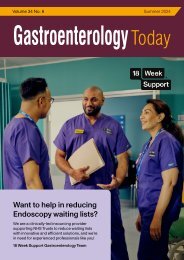Gastroenterology Today Winter 2022
Gastroenterology Today Winter 2022
Gastroenterology Today Winter 2022
Create successful ePaper yourself
Turn your PDF publications into a flip-book with our unique Google optimized e-Paper software.
ADVERTORIAL FEATURE<br />
A COST-EFFECTIVE SOLUTION<br />
FOR IMMEDIATE IDENTIFICATION<br />
OF GASTRIC CANCER RISK<br />
Improving gastric cancer survival rates requires timely<br />
detection to enable proactive therapeutic interventions.<br />
Currently, late diagnosis means that only 21 % of UK<br />
patients identified as having gastric cancer survive longer<br />
than five years, but this figure could increase to 65 % with<br />
earlier medical care. 1 However, standard gastrointestinal<br />
diagnostic methods – like endoscopies and biopsies – place<br />
a considerable burden on the healthcare system, highlighting<br />
a need for an efficient investigative pathway for digestive<br />
complaints.<br />
The challenge of diagnosing gastric cancer<br />
Gastric carcinogenesis is a lengthy multi-step process, called the<br />
‘Correa’s Cascade’, 2,3 that begins with chronic H. pylori infection<br />
and progresses through multiple stages of infl ammation, wasting<br />
of healthy mucosa, and propagation of abnormal gastric cells.<br />
There is a small window of opportunity within this disease cycle for<br />
prompt detection and action to prevent the cascade from advancing.<br />
However, the diverse presentation of gastrointestinal disorders makes<br />
early-stage stomach cancer diffi cult to identify. Many patients with<br />
serious pathological changes to their stomach lining have few or no<br />
symptoms, so those most at risk of progression to gastric cancer are<br />
not easily identifi able. 4 Conversely, individuals who present with nonspecifi<br />
c stomach complaints – ranging from mild discomfort to nausea<br />
and vomiting – are often sent straight for endoscopy unnecessarily.<br />
Drawbacks of gastroscopies<br />
The key to cost-effective diagnosis<br />
GastroPanel ® , a simple blood test produced by BIOHIT HealthCare,<br />
measures a combination of these biomarkers – pepsinogen I,<br />
pepsinogen II, gastrin-17 and H. pylori IgG – in order to establish gastric<br />
cancer risk and highlight individuals who would benefi t from further<br />
examination. Initial analysis of gastrointestinal status with GastroPanel<br />
could reduce reliance on precious NHS gastroscopy resources by up<br />
to 90 %, enabling early detection and proactive treatment to reduce<br />
waiting times and improve care pathways for more vulnerable patients.<br />
And, at a cost of just £30 per test, employing GastroPanel in primary<br />
and secondary care settings has the potential to cut annual procedural<br />
costs to only £14.4 million, saving the NHS an incredible £69 million<br />
each year.<br />
To find out more about BIOHIT HealthCare’s GastroPanel®, visit:<br />
https://biohithealthcare.co.uk/biohit-product/gastropanelpepsinogen-i-pepsinogen-ii-h-pylori-igg-and-gastrin-17-elisas/<br />
References<br />
1. Cancer Research UK, https://www.cancerresearchuk.org/healthprofessional/cancer-statistics/statistics-by-cancer-type/stomachcancer/survival#heading-Three.<br />
Accessed 25 th October <strong>2022</strong>.<br />
2. Correa P, Haenszel W, Cuello C, et al. A model for gastric cancer<br />
epidemiology. Lancet. 1975;2(7924):58-60. doi: 10.1016/s0140-<br />
6736(75)90498-5. PMID: 49653.<br />
3. Correa P. A human model of gastric carcinogenesis. Cancer Res.<br />
1988;48(13):3554-60. PMID: 3288329.<br />
Endoscopy is the standard technique for identifying atrophic gastritis<br />
and related gastric cancer lesions. However, use of gastroscopy as<br />
a fi rst-line diagnostic tool places a signifi cant burden on the NHS,<br />
as this method is resource heavy, labour intensive and tends to be<br />
poorly accepted by patients due to its invasive nature. In addition,<br />
at a cost of £436 per procedure, 5 conservative calculations show<br />
that gastroscopies could be responsible for over £84 million of the<br />
NHS annual spend, based on the estimate that 3,000 diagnostic<br />
oesophagogastroduodenoscopies (OGDs) are performed per 250,000<br />
people each year. 6 With this in mind, researchers have identifi ed<br />
several serological biomarkers that can effectively characterise<br />
key aspects of gastric mucosal health before any more substantial<br />
investigation is required, directing treatment when milder conditions<br />
are indicated and identifying at-risk patients for whom endoscopy may<br />
be necessary.<br />
4. Chapelle, N., Petryszyn, P., Blin, J., et al. A panel of stomachspecifi<br />
c biomarkers (GastroPanel ® ) for the diagnosis of atrophic<br />
gastritis: A prospective, Multicenter Study in a low gastric cancer<br />
incidence area. Helicobacter. 2020;25(5):e12727. doi: 10.1111/<br />
hel.12727.<br />
5. NHS England. <strong>2022</strong>/23 National Tariff Payment System: Annex A -<br />
National tariff workbook. https://www.england.nhs.uk/wp-content/<br />
uploads/2020/11/22-23NT_Annex-A-National-tariff-workbook_<br />
Apr22.xlsx. Accessed 10 th November <strong>2022</strong>.<br />
6. Beg S, Ragunath K, Wyman A, et al. Quality standards in upper<br />
gastrointestinal endoscopy: a position statement of the British<br />
Society of <strong>Gastroenterology</strong> (BSG) and Association of Upper<br />
Gastrointestinal Surgeons of Great Britain and Ireland (AUGIS). Gut.<br />
2017;66(11):1886-1899. doi: 10.1136/gutjnl-2017-314109.<br />
GASTROENTEROLOGY TODAY - WINTER <strong>2022</strong><br />
9

















